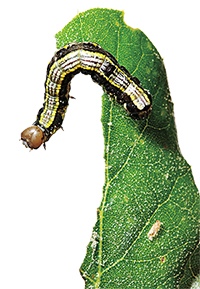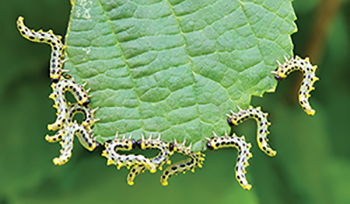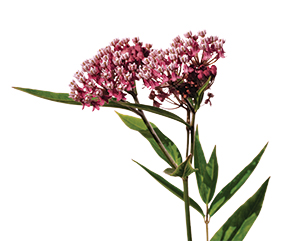
Audubon Adventures

Background for Teachers
 Plants are Earth’s food base. Most land birds, and in fact most land-dwelling species of all animals, feed on plants—either directly by eating plant tissues (leaves, seeds, fruit) or by drinking plant sap and nectar, or indirectly by eating animals that eat plants. The green color of plants’ leaves and stems comes from pigments called chlorophylls. These chemicals enable plants and some microscopic organisms to do something nothing else on Earth can do: convert solar energy to chemical energy through the process of photosynthesis, which combines carbon dioxide with water to produce natural sugars. (A waste product of this process is oxygen, which almost all animals need to survive.) By taking in carbon dioxide, plants help regulate the amount of this greenhouse gas in the atmosphere, thus helping to control global climate change.
Plants are Earth’s food base. Most land birds, and in fact most land-dwelling species of all animals, feed on plants—either directly by eating plant tissues (leaves, seeds, fruit) or by drinking plant sap and nectar, or indirectly by eating animals that eat plants. The green color of plants’ leaves and stems comes from pigments called chlorophylls. These chemicals enable plants and some microscopic organisms to do something nothing else on Earth can do: convert solar energy to chemical energy through the process of photosynthesis, which combines carbon dioxide with water to produce natural sugars. (A waste product of this process is oxygen, which almost all animals need to survive.) By taking in carbon dioxide, plants help regulate the amount of this greenhouse gas in the atmosphere, thus helping to control global climate change.
Plants are the foundation of most of the planet’s ecosystems, the natural networks formed by the interrelationships among various living and nonliving components. In addition to providing the Earth’s food base, plants also provide habitat for most terrestrial and many aquatic animals at some point in their lives.
 The Bird-Plant-Insect Connection
The Bird-Plant-Insect Connection
Birds are particularly dependent on plants. Vast numbers of birds build their nests in shrubs and trees and use plant materials for construction. Birds retreat to trees and bushes as protection from predators and to rest and roost. And directly or indirectly, plants provide all the foods that birds eat. Seeds, nuts, and fruit help sustain many birds all year long, and some species also nibble nutritious plant buds or sip flower nectar. But when it comes to nesting season, plants support most land birds in a slightly more indirect way: by hosting the protein-rich insects that baby birds need to develop properly. Indeed, 96 percent of land birds feed insects to their young. And the majority of these insects need plants to survive. They lay their eggs on plants, eat plant tissues, suck plant sap and nectar, eat flower pollen, and even consume decaying or dead plant material.
This beneficial relationship isn’t just a one-way street. Many plants, in turn, depend on birds, as well as insects and other animals, for reproduction. These mobile partners carry grains of pollen (the male sex cells) from one flower to another, where they fertilize the female sex cells (the ova, or eggs). This process of cross-pollination allows the flowers to produce genetically diverse seeds. In addition to pollination, by dining on insects that dine on plants, birds are a natural pest control service for plants, which might otherwise be overwhelmed and lethally damaged.
Why “Native” Matters
This bird-plant interdependence works best in a healthy habitat dominated by native plants. Those are the plants that have historically grown in a particular area and evolved with the insects, birds, and other wildlife that also live there. Because native plants and native birds have evolved together over millions of years, these are the plants that provide nutrient-rich fruit, seeds, and nectar when native birds need them most. In North America, the fruit of native shrubs and trees has been shown to have a much higher fat content—as much as 50 percent fat—than the fruit of nonnative species. Migrating and wintering birds rely on that rich fruit to survive. And, native plants have evolved over an even longer period with native insects, the vast majority of which are specialists: They need the exact plants with which they’ve evolved to survive. Without those native plants, native insects have nowhere to lay their eggs, and nothing to eat. And a habitat without those insects is one with very little protein-rich food for parent birds to feed their young.
Unfortunately, native plant-poor and insect-poor habitats have come to dominate much of North America over the past few centuries. A goal of the horticultural and landscaping industries has been to develop and plant “pest-free” plants, meaning plants that are not palatable to insects. Many nonnative species have been planted just for this reason, and now about 80 percent of plants in suburban and urban areas are nonnative. While these plants may be beautiful, they do not support native insect life, and as a result do not provide the food birds need during the breeding season. Because nonnative plants are not eaten by native insects, they can often outcompete native plant species, and become invasive. Recent scientific research points to native landscaping as a key tool in increasing bird diversity and abundance. For example, in a study of suburban properties in southeast Pennsylvania by Dr. Douglas Tallamy of the University of Delaware, researchers found eight times more Wood Thrushes, Eastern Towhees, Veeries, and Scarlet Tanagers in yards with native plantings as compared with yards landscaped with typical alien ornamentals.

Numbers Tell the Tale
How many caterpillars does it take to raise a nest of chickadee chicks? The answer is astounding: up to 9,000! Since the majority of caterpillars—the larval stage of many kinds of insects—hatch from eggs laid on plants and/or consume plants as they progress through metamorphosis, it’s clear that one reason birds need plants is that insects need plants. And a comparison of native oak trees with nonnative Ginkgo trees makes it clear why “native” is a key element in this food-chain math: Native oak trees are host to more than 550 species of moth and butterfly caterpillars. The Ginkgo, a common ornamental landscaping tree from Asia, supports only five species.
What’s Native, What’s Not?
Alien, exotic, introduced, non-indigenous—nonnative plants go by many names. An invasive nonnative plant is one not natural to an area and that runs rampant once introduced. Very invasive nonnative plants may be termed noxious weeds.
Many nonnative plants travel here from other lands, but even a plant native to one region in the United States can be an invasive nonnative plant in another. Black locust trees, for example, are native to the Southeastern United States. Introduced and naturalized in the Northeast, however, they have become a pest, altering the landscape and crowding out lupines, a native wildflower. As lupines decline, so too do Karner blue butterflies, a unique sapphire-blue species that requires lupine leaves to feed its caterpillars. Lupines, butterflies…what might be the next victim of this invasion?
Green Is Not Always Good
Consider English ivy, popular as a houseplant and also in landscaping. This attractive and hardy evergreen groundcover and climbing vine, originally from Europe, as its name implies, is relatively “pest-free” because few native insects eat it. As a result, it can outcompete native plants and ruin a healthy habitat that once supported native birds and other wildlife. When English ivy takes hold in a woodland habitat, for example, its fast-growing vines begin to cover the ground and climb up tree trunks. The thick shade cast by its waxy evergreen leaves prevents wildflowers and tree seedlings from sprouting, reducing the woodland floor to a solid carpet of ivy. As the ivy winds up and around the trees, it competes with them for sunlight, too. Its hold-fast roots also damage bark. The sheer weight of the ivy can even pull down branches over time. English ivy isn’t a friend to woodland creatures, either. Few birds eat its berries save for nonnative European Starlings, House Sparrows, and a few others. It offers shelter primarily for another invader—the Norway rat.
The native plants that once populated this woodland evolved over thousands and even millions of years, adapting to this habitat’s particular soil and weather conditions. In turn, they created and defined the habitat, providing food and shelter for native birds and other wildlife. Native birds nesting here found an abundant and diverse supply of insects to feed their growing young, and migratory birds stopping over found nutritious fruit to fuel their long journeys. Now this balance, fine-tuned over millennia, is under siege from plants that did not evolve here—nonnative plants that, without human assistance, would probably never have arrived here.
What’s to Be Done?
Individuals can play a big role in establishing, protecting, and restoring healthy habitats that are built on a foundation of native plants. In doing so, they can help support birds during breeding season, migration, and through cold winters. Homeowners generally have control over their yards and thus on what lives and grows there. Thinking of a yard as habitat is key. Even the greenest, most ornamental yard can be a virtual desert for native birds, insects, and other animals if it doesn’t contain native plants. The same is true of parks and other public spaces. Careful choices of native wildflowers, trees, shrubs, and vines can recreate a natural habitat that provides nesting places, food for nestlings, and nutritious food for hungry migrating and wintering birds. Besides the benefits to wildlife and the surrounding habitat, established native plants often require less watering and are more apt to survive and thrive with less intensive (and expensive) care than nonnative species.
 Now it’s easier than ever for homeowners and property managers, including those at schools and parks, to find bird-friendly plants for yards, gardens, open spaces, and schoolyards. Audubon’s new native plant database is a searchable listing of nearly 3,000 plants and trees native to different parts of the United States. You and your students can search Audubon’s native plant database to find which plants in your area are best for birds.
Neighbors and local groups can support efforts to protect, preserve, and restore wild places. That can include advocating for and working with local government entities to raise awareness and identify places that need protection or restoration. Individuals can also organize or volunteer for efforts to remove invasive nonnative plants and replace them with natives in local spaces that are shared by the community.
Now it’s easier than ever for homeowners and property managers, including those at schools and parks, to find bird-friendly plants for yards, gardens, open spaces, and schoolyards. Audubon’s new native plant database is a searchable listing of nearly 3,000 plants and trees native to different parts of the United States. You and your students can search Audubon’s native plant database to find which plants in your area are best for birds.
Neighbors and local groups can support efforts to protect, preserve, and restore wild places. That can include advocating for and working with local government entities to raise awareness and identify places that need protection or restoration. Individuals can also organize or volunteer for efforts to remove invasive nonnative plants and replace them with natives in local spaces that are shared by the community.
Avoiding or reducing the use of herbicides and pesticides is another step. Letting caterpillars and insects munch on plants is a small price to pay for keeping poison out of the habitat and providing a safe food source for native birds and other animals. In addition, the chemicals can eventually end up in groundwater and bodies of water, harming habitats far beyond our property lines.
Scientific research shows that native plants benefit native birds and other wildlife. Those benefits extend to people, too, because we share the same habitats. Starting in our yards, schoolyards, and public spaces, when we plant native plants, we are helping to make our communities healthier and safer for all living things.
Photos: Sean Graesser; iStock (4).




